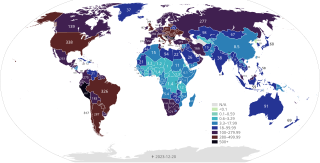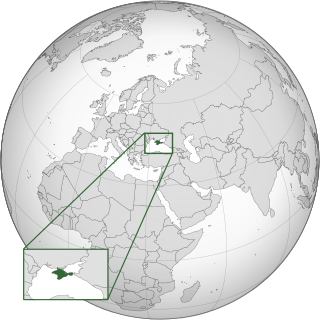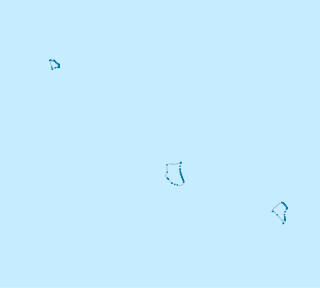Novel coronavirus (nCoV) is a provisional name given to coronaviruses of medical significance before a permanent name is decided upon. Although coronaviruses are endemic in humans and infections normally mild, such as the common cold, cross-species transmission has produced some unusually virulent strains which can cause viral pneumonia and in serious cases even acute respiratory distress syndrome and death.

The COVID-19 pandemic, also known as the coronavirus pandemic, is a global pandemic of coronavirus disease 2019 (COVID-19) caused by severe acute respiratory syndrome coronavirus 2 (SARS-CoV-2). The novel virus was first identified in an outbreak in Wuhan, the capital of Hubei, China, in December 2019, before it spread to other areas of Asia, and then worldwide in early 2020. The World Health Organization (WHO) declared the outbreak a public health emergency of international concern (PHEIC) on 30 January 2020, and assessed the outbreak had become a pandemic on 11 March 2020. The WHO ended the PHEIC on 5 May 2023. As of 28 March 2024, the pandemic has caused 7,037,007 confirmed deaths, making it the fifth deadliest pandemic or epidemic in history.
Chinese coronavirus may refer to:

Coronavirus diseases are caused by viruses in the coronavirus subfamily, a group of related RNA viruses that cause diseases in mammals and birds. In humans and birds, the group of viruses cause respiratory tract infections that can range from mild to lethal. Mild illnesses in humans include some cases of the common cold, while more lethal varieties can cause SARS, MERS and COVID-19. As of 2021, 45 species are registered as coronaviruses, whilst 11 diseases have been identified, as listed below.

This is a general overview and status of places affected by severe acute respiratory syndrome coronavirus 2 (SARS-CoV-2), the virus which causes coronavirus disease 2019 (COVID-19) and is responsible for the COVID-19 pandemic. The first human cases of COVID-19 were identified in Wuhan, the capital of the province of Hubei in China in December 2019.

The COVID-19 pandemic in Liechtenstein was a part of the ongoing worldwide pandemic of coronavirus disease 2019 caused by severe acute respiratory syndrome coronavirus 2. The virus was confirmed to have reached Liechtenstein in early March 2020. With a total population of 38,896 and 54 confirmed deaths, the country has one of the highest rate of confirmed deaths per capita in the world.

The COVID-19 pandemic in Panama was a part of the worldwide pandemic of the coronavirus disease caused by severe acute respiratory syndrome coronavirus 2. The virus was confirmed to have spread to Panama on 9 March 2020. One of the dead was a 64-year-old male, who also had diabetes and pneumonia. Of those infected, 83 were hospitalized. The infected individuals belonged to the 29-59 age group and had each recently travelled abroad. A 13-year-old girl died of COVID-19 on 23 March 2020.

The COVID-19 pandemic in Paraguay was a part of the ongoing worldwide pandemic of coronavirus disease 2019 caused by severe acute respiratory syndrome coronavirus 2. The virus was confirmed to have reached Paraguay on March 7, 2020, in a 32-year-old man from Guayaquil, Ecuador, living in San Lorenzo, Central Department. Three days later, on March 10, 2020, a second case was confirmed in a 61-year-old man who traveled from Argentina; the same day three more cases were confirmed. Due to this spike, the government began imposing the first measures to stop the disease from spreading.
The COVID-19 pandemic in Greenland was a part of the ongoing worldwide pandemic of coronavirus disease 2019 caused by severe acute respiratory syndrome coronavirus 2. The virus was confirmed to have spread to Greenland, an autonomous territory of the Kingdom of Denmark, in March 2020. As of 27 May 2020, there had been 13 confirmed cases, but none were in need of hospitalization. Among the first 11, the last infected person had recovered on 8 April 2020, and after that, Greenland has had no known active cases. After a period of time without any new confirmed cases, one was confirmed on 24 May when a person tested positive at the entry into the territory, and another was confirmed at entry on 27 May 2020.
The COVID-19 pandemic in the Marshall Islands is part of the ongoing worldwide pandemic of coronavirus disease 2019 caused by severe acute respiratory syndrome coronavirus 2. The virus was confirmed to have reached the Marshall Islands on 28 October 2020, but remained confined to quarantined arrivals until August 2022. The first known community transmission cases of COVID-19 were confirmed in Majuro on August 8, 2022, ending the country's COVID-free status. The first confirmed death from COVID-19 in the Marshall Islands occurred on August 11, 2022.
The COVID-19 pandemic in Guatemala was a part of the worldwide pandemic of coronavirus disease 2019 caused by severe acute respiratory syndrome coronavirus 2. The virus was confirmed to have reached Guatemala in March 2020.

Christian Heinrich Maria Drosten is a German virologist whose research focus is on novel viruses (emergent viruses). During the COVID-19 pandemic, Drosten came to national prominence as an expert on the implications and actions required to combat the illness in Germany.
The COVID-19 pandemic in Tuvalu is part of the ongoing worldwide pandemic of coronavirus disease 2019 caused by severe acute respiratory syndrome coronavirus 2. The virus was confirmed to have reached Tuvalu on 20 May 2022. As of 31 August 2022, a total of 25,591 vaccine doses have been administered.

The COVID-19 pandemic was confirmed to have reached the Luhansk People's Republic (LPR), a disputed Russian republic in eastern Ukraine, in March 2020. For the rest of Ukraine, see COVID-19 pandemic in Ukraine.

The COVID-19 pandemic was confirmed to have reached the Ukrainian territory of Crimea in March 2020. The Russian government includes cases in the Republic of Crimea in the count of cases in Russia.
The COVID-19 pandemic was confirmed to have reached Sevastopol in March 2020. The Russian government includes the cases in Sevastopol in the count of cases in Russia.

The COVID-19 pandemic in the Kurdistan Region is part of the ongoing worldwide pandemic of coronavirus disease 2019 caused by severe acute respiratory syndrome coronavirus 2. The COVID-19 disease was first confirmed to have reached the Kurdistan Region, an autonomous region of Iraq, on 1 March 2020.

The COVID-19 pandemic in Tokelau is part of the ongoing worldwide pandemic of coronavirus disease 2019 caused by severe acute respiratory syndrome coronavirus 2. Tokelau reported its first confirmed case on 21 December 2022. COVID-19 reached all three of Tokelau's main atolls in July 2023, when the government confirmed the community spread of the virus on Fakaofo, the last atoll without infections.

The COVID-19 pandemic in the British Indian Ocean Territory is part of the ongoing worldwide pandemic of coronavirus disease 2019 caused by severe acute respiratory syndrome coronavirus 2. The virus was confirmed to have reached Diego Garcia of the British Indian Ocean Territory in November 2020.

The COVID-19 pandemic is an ongoing viral pandemic of coronavirus disease 2019 (COVID-19), a novel infectious disease caused by severe acute respiratory syndrome coronavirus 2 (SARS-CoV-2). This pandemic has affected the Regional Municipality of York since early 2020 and has led to lockdowns as well as stay-at-home orders made by the Government of Ontario. A vaccination program began in December 2020 and is currently ongoing.












